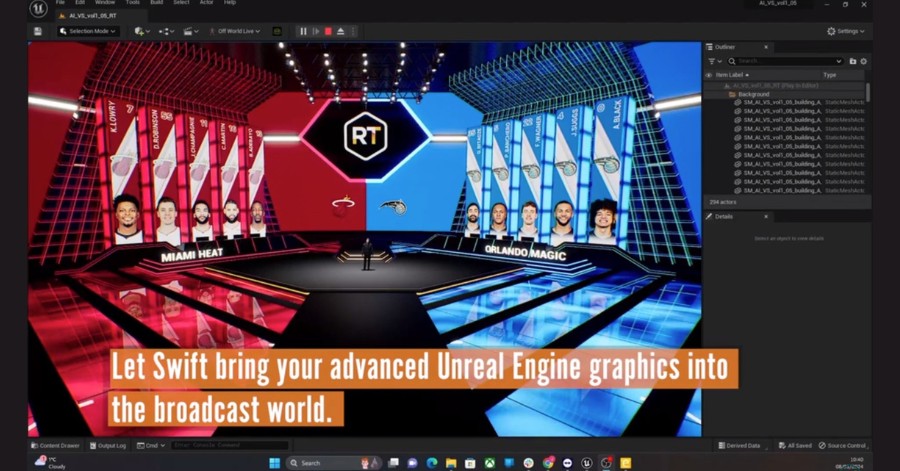RT Software has released a significant new feature to enhance its Swift Studio solution for virtual studios and augmented reality graphics. Unreal Engine™ projects were already supported within the Swift environment, however now it is possible to link Unreal’s dynamic fields into those in Swift’s graphics, allowing incredible versatility and flexibility when it comes to triggering graphics to air. It gives an operator the ability to interact with Unreal Engine’s graphics live on air, through their familiar Swift Live browser interface.
To add a little background to this topic, Unreal Engine™ is well known for its 3D games engine which has increasingly been used in other industries, whenever complex high quality 3D visualisations are needed.
This expansion into new territories now covers broadcast, however live broadcast operations depend on intuitive user interfaces that are familiar and consistent across an entire broadcast facility. It is important that operators are able to respond immediately to live events within news or sports programmes and avoid embarrassing on air mistakes. Introducing a different way to control a subset of a broadcaster’s graphics is a risk to live operations.
By using the same Swift solution for all areas of a broadcast facility, irrespective of whether Unreal Engine™ is being used, the need for retraining on specific events is avoided, whilst still retaining the option to include the high quality graphics from Unreal Engine™ whenever required. RT Software’s approach allows a mix and match approach to on air graphics.
The most powerful part of the solution is that Unreal Engine™ graphics retain their ability to be dynamically updated through the Swift Live interface when they go to air. Dynamic aspects could include anything from onscreen text fields, to lighting colours, in fact anything you might want to change when a graphic goes to air. This capability could be used to change a virtual studio’s lighting to match a winning team’s colours, for example.
The entire process starts with the Swift CG+ editor, when the Unreal Engine’s blueprints (their dynamic fields) are mapped to relevant fields in the Swift editor. Once the graphic has been distributed to the renderer, the gallery operator can call up each graphic via their Swift Live browser interface, create a playlist, modify values, preview, and trigger to air at the right moment.
Mike Fredriksen, RT Software Commercial Director said, “We are always looking for ways to make it easy for our customers to take advantage of the latest developments in technology and there is definitely interest in working with Unreal Engine. We embedded Unreal Engine alongside our own a while back, and now those graphics can benefit from our full suite of web based Swift products. This includes intuitive and unified manual graphics control using Swift Live, automated data and asset ingest with MediaWatcher and graphics project management with Repository. This really simplifies putting Unreal graphics to air, something we know customers place a high value on. We have provided a winning solution here by allowing Unreal Engine graphics to exist within Swift. It delivers the best of both worlds.”
Watch the Video:
Unreal Engine - integration demo- short from RT Software on Vimeo.
Info: www.rtsw.co.uk & AmyDV *
* Distributor for Hellas
Notes: Press Release - RT Software - London, UK, March 2024






